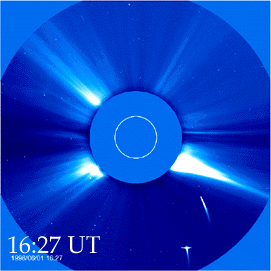Sun-grazing Comet
A comet that approaches the Sun’s photosphere to within about 50,000 km at perihelion is known as a ‘sun-grazing comet’. At this distance the comet passes through the solar atmosphere, and while many survive the intense solar heating to complete several orbits, others disintegrate quickly and some may even fall into the Sun.
The majority of sun-grazing comets are known as the ‘Kreutz Sungrazers’ after the German astronomer Heinrich Kreutz. In the 1890s he found that all true sun-grazers followed the same orbit, indicating that they all originated from a single comet that had fragmented. About 90% of the 1,000-odd sun-grazing comets so far observed with the Large Angle Spectrometric Coronagraph on the Solar and Heliospheric Observatory (SOHO), are members of the Kreutz group, and most measure a few tens of metres across.
Study Astronomy Online at Swinburne University
All material is © Swinburne University of Technology except where indicated.


